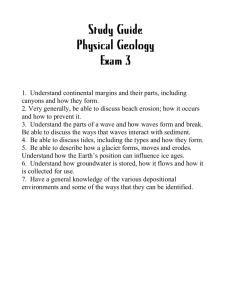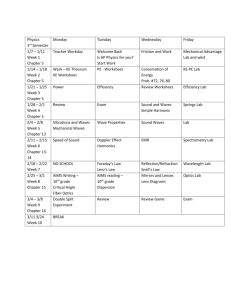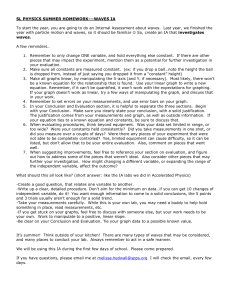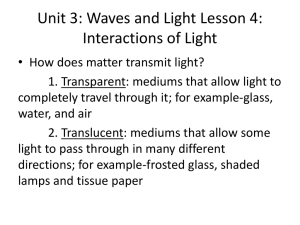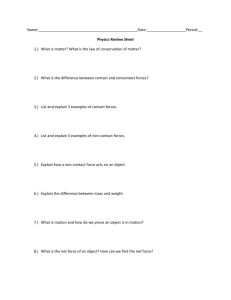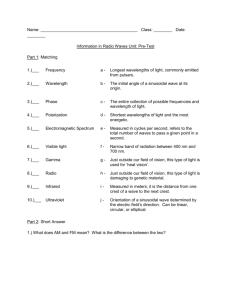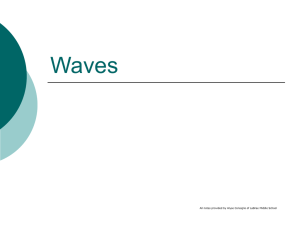WaveRadiation
advertisement
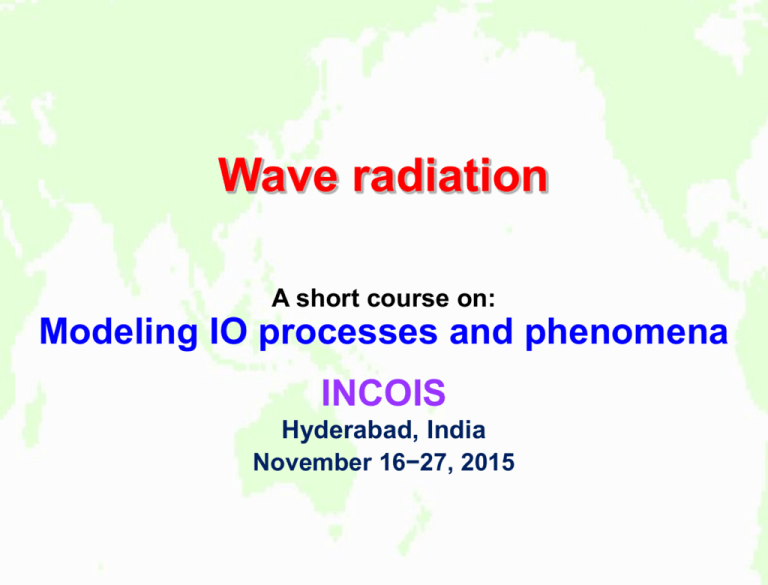
Wave radiation A short course on: Modeling IO processes and phenomena INCOIS Hyderabad, India November 16−27, 2015 References 1) HIGnotes.pdf: beginnings of Sections 3−5. McCreary, J.P., 1980: Modeling wind-driven ocean circulation. JIMAR 80-0029, HIG 80-3, Univ. of Hawaii, Honolulu, 64 pp. 2) KelvinWaves.pdf: A write-up of the Kelvin-wave solution. Mode equations Let q be u, v, or p of the LCS model. To focus on free waves, neglect forcing, friction and damping terms. Then, equations of motion for the 2-d qn(x,y,t) fields are Solutions to these with equations describe how Waves associated a superposition of waves verticalassociated modes with a single vertical mode propagate horizontally. propagate both horizontally and vertically. vn equation Solving the unforced, inviscid equations for a single equation in vn, and for convenience dropping subscripts n gives (1) Okay. This equation so important maybe should Problem #1: Solveis the equations ofthat motion to we obtain (1).derive it in class! Derivation of vn equation (−1) Derivation of vn equation (−1/cn2) Derivation of vn equation vn equation Solving the unforced, inviscid equations for a single equation in vn, and for convenience dropping subscripts n gives (1) Solutions to (1) are difficult to find analytically because f is a function of y and the equation includes y derivatives (the term vyyt). There are, however, useful analytic solutions to approximate versions of (1). Dispersion relation of free waves The simplest approximation (mid-latitude β-plane approximation) simply “pretends” that f and β are both constant. Then, solutions have the form of plane waves, Then, we can set ∂t = −iσ, ∂x = ik, and ∂y = iℓ in (1), resulting in the dispersion relation, The dispersion relation provides a “biography” for a model. It describes everything about the waves it supports. Gravity waves with f = 0 The simplest dispersion relation has f = 0, in which case the waves are non-dispersive gravity waves. For convenience, the plot shows curves for ℓ = 0. When ℓ ≠ 0, the curves define a surface. At each σ, the disp. rel. gives a circle of radius r = σ/c, so the surface is a circular cone. The phase speed of the waves is σ/k = ±c. The property that dispersion curves are linear (straight lines) indicates that the waves are non-dispersive. σ/f 1- α = f/c = R−1 −1 k/α 1 Gravity waves with constant f When f ≠ 0 and is constant, the possible waves are dispersive, gravity waves. There are no waves with frequencies < f. For convenience, the plot shows curves when ℓ = 0. When ℓ ≠ 0, the curves define a surface. At each σ, the disp. rel. is a circle with r = (σ2−f2)½/c and its center at k = ℓ = 0. So, the surface is a circular bowl. The phase speed, σ/k, is no longer linear, indicating that the waves are dispersive. σ/f f=0 1- −1 −1 k/α 1 Gravity waves with variable f (β ≠ 0) When f ≠ 0 and β ≠ 0, the waves are still dispersive, gravity waves, but the curves are modified by the β term. For convenience, the plot shows σ/f curves for ℓ = 0. When ℓ ≠ 0, the disp. rel. still defines a circle for each σ with its center at k = −β/(2σ), ℓ = 0 and its radius modified from (σ2−f2)½/c. So, the surface is still a circular bowl. 1 - −1 k/α 1 Rossby waves When σ is small, the σ2/c2 term is small relative to f2/c2, giving the disp. rel. for RWs. Rossby exist only for negative k, and so propagate westward. σ/f When ≠ 0, the disp. rel. still Freq. σℓattains a maximum 1defines a circle σ when with value when r →for 0, each that is, its at k ==−β/(2σ), =0 σ =center ½(c/f)(β/f) ½R/Re. ℓSo, 2/(4σ2) − bowl. and a radiusisr an = βinverted f2/c2. the surface Typically, R/Re « 1, so that the RW and GW bands are well separated. R/2Re −1 k/α 1 Kelvin waves To derive the dispersion relation for GWs and RWs, we solved for a single equation in v. So, we missed a wave with v = 0, the coastal Kelvin wave. The dispersion curves shown in σ/f the figure and equation are for Problem Okay. The #2: Solve solution theisequations easy, of Kelvin waves along zonal 1motion insightful, to obtain and important, the Kelvin-wave so boundaries. KWs also exist solutions. maybe we should derive it in class! along meridional boundaries. The coastal KW propagates along coasts at speed c with the coast to its right, and decays offshore with the decay scale c/f = R, the Rossby radius of deformation. −1 k/α 1 Derivation of KW solution (−c2) Derivation of KW solution (−1) Derivation of KW solution Look for solutions proportional to exp(ikx –iσt). Set ∂t = −iσ and ∂x = ik. Phase and group speed The figure shows the wave types that we have discussed. The phase speed of a wave with wavenumber k and frequency σ is the slope of the line that extends from (0,0) to (σ,k). σ/f 1 - The group speed of a wave with wavenumber k and frequency σ is the slope of the line parallel to the dispersion curve at the point (σ,k). R/2Re Movies A1, A3, A2 −1 k/α 1
